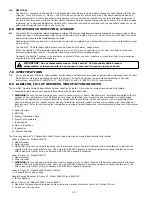
8
DESCENDING:
To descend the ladder, climb down smoothly while maintaining three points of contact at all times (with
hands and feet). Allow the Lad-Saf
™
X2 Detachable Cable Sleeve to “lead” the climber down. Climbing down out of position
(e.g., leaning back excessively or climbing erratically) may cause the sleeve to lock onto the carrier cable. If the sleeve
locks, climb upward slightly to allow the sleeve to unlock and then continue to descend the ladder. Reconnect the carrier
cable into the cable guides after passing each cable guide.
Do not handle or remove the sleeve from the carrier cable
when passing the cable guides or if the sleeve locks.
When climbing is completed (see Figure 2):
Step 1.
Remove the sleeve from the cable by rotating the locking lever (G).
Step 2.
Pull back on the side plate (C) and pivot the handle (D) to its full upright position.
Step 3.
The sleeve can now be removed from cable and properly stored.
•
Identify hazards to avoid climber injury.
•
Hazardous environments or conditions include, but are not limited to; power lines, heat or flame,
explosive gases, physical obstructions, and climbers ability and health.
IN THE EVENT OF A FALL, The Lad-Saf
™
X2 Detachable Cable Sleeve must be removed from service.
The user (employer) must have a rescue plan in place and the ability to implement the plan in the
event of a fall.
4.0 TRAINING
4.1 TRAINING:
Users and purchasers of this equipment must be trained in the correct care and use of this equipment as
detailed in this manual. It is the responsibility of the user and purchaser of this equipment to assure they are familiar with
these instructions, operating characteristics, application limits, and the consequences of improper use of this equipment.
Training must be conducted without exposing the user to a fall hazard. Training should be repeated
on a periodic basis.
Step 1.
Attach sleeve to approved carrier cable. Use a full body harness with frontal D-Ring and attach to Lad-Saf
™
X2
Detachable Cable Sleeve.
Step 2.
Ascend the ladder to approximately three feet. With both hands and feet on the climbing structure flex knees in
a quick sitting motion to simulate a fall and activate the sleeve.
Step 3.
After the sleeve locks, move upward to unlock the sleeve. Repeat Steps 2 and 3 several times to become
familiar with sleeve operation.
Step 4.
Descend the ladder to the ground and detach the sleeve connection. Remove the sleeve from the cable.
5.0 INSPECTION
5.1 FREQUENCY:
See Figure 2 for identification of the components described in the following guidelines:
•
Before Each Use:
Visually inspect the full body harness, Lad-Saf
™
X2 Detachable Cable Sleeve, Lad-Saf™ Ladder
System installation, and ladder structure. Use the guidelines provided in section 5.3 or 5.4 to check the system to the
extent possible before attaching. Check the system label (section 8) to verify that annual inspection is current.
If the
condition of the system is in doubt, do not use.
•
Periodic Formal Inspection:
A formal inspection of the Lad-Saf
™
X2 Detachable Cable Sleeve, Lad-Saf
™
Ladder
System installation, and the ladder structure must be performed at least annually by a competent person other than
the user. See Sections 5.3 and 5.4 for inspection specifics. Record the results at the end of this manual.
•
After a Fall:
If a fall occurs with the Lad-Saf
™
Ladder System a formal inspection of the entire system must be
performed by a competent person other than the user.
A separate fall protection system must be used while
inspecting the Lad-Saf system.
See sections 5.3, 5.4 and 5.5. Record the inspection results in the
Inspection and
Maintenance Logs
at the end of this manual.
5.2
If inspection reveals an unsafe or defective condition
remove the Lad-Saf
™
X2 Detachable Cable Sleeve or the
Lad-Saf
™
Ladder System from service. Contact an authorized service center for repair or destroy the sleeve. DO NOT
ATTEMPT UNAUTHORIZED REPAIR. Record the results of this inspection in the
Inspection and Maintenance Log
in this
manual.
5.3
INSPECTION GUIDELINES - LAD-SAF™ DETACHABLE CABLE SLEEVE:
See Figure 2 for identification of the components
described in the following guidelines:
•
Inspect the handle/energy absorber/fall indicator (item D) for bends, cracks, and deformities. All fasteners must be
securely attached. Operation of handle and cam must be free and smooth. Springs must be secure and of sufficient
strength to pull handle down.
The handle/energy absorber/fall indicator will be deformed if it has been used for fall arrest. Figure 17 shows an
example of a handle/energy absorber/fall indicator that has not been used for fall arrest (1) and a handle/energy
absorber that has been used for fall arrest and is deformed (2).
If the handle/energy absorber is deformed,
DO NOT USE. The sleeve must be removed from service.
•
Inspect the locking lever (item G) for smooth operation, ensuring it springs back into its locked position when
released.
Содержание LAD-SAF
Страница 2: ...2 2 3 i ii J J A B G K L I H D E F C G O C A M I D 1 2 4 5 A B A B C 6 7 I A G...
Страница 4: ...4 14 15 16 23cm 9 MAX 1 2 1 1 X X X X X X X X 17 2 1...
Страница 85: ......
Страница 86: ......









































